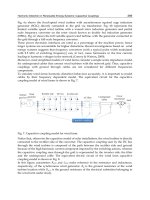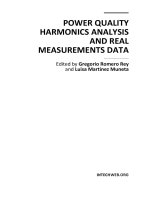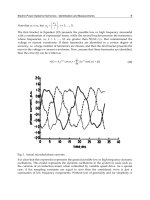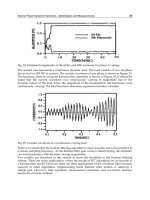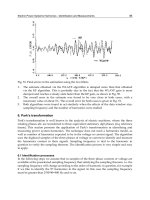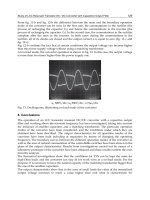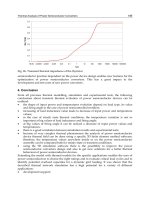Power Quality Monitoring Analysis and Enhancement Part 1 potx
Bạn đang xem bản rút gọn của tài liệu. Xem và tải ngay bản đầy đủ của tài liệu tại đây (610.51 KB, 25 trang )
POWER QUALITY –
MONITORING, ANALYSIS
AND ENHANCEMENT
Edited by Ahmed Faheem Zobaa,
Mario Mañana Canteli and Ramesh Bansal
Power Quality – Monitoring, Analysis and Enhancement
Edited by Ahmed Faheem Zobaa, Mario Mañana Canteli and Ramesh Bansal
Published by InTech
Janeza Trdine 9, 51000 Rijeka, Croatia
Copyright © 2011 InTech
All chapters are Open Access articles distributed under the Creative Commons
Non Commercial Share Alike Attribution 3.0 license, which permits to copy,
distribute, transmit, and adapt the work in any medium, so long as the original
work is properly cited. After this work has been published by InTech, authors
have the right to republish it, in whole or part, in any publication of which they
are the author, and to make other personal use of the work. Any republication,
referencing or personal use of the work must explicitly identify the original source.
Statements and opinions expressed in the chapters are these of the individual contributors
and not necessarily those of the editors or publisher. No responsibility is accepted
for the accuracy of information contained in the published articles. The publisher
assumes no responsibility for any damage or injury to persons or property arising out
of the use of any materials, instructions, methods or ideas contained in the book.
Publishing Process Manager Sandra Bakić
Technical Editor Teodora Smiljanic
Cover Designer Jan Hyrat
Image Copyright Sergej Razvodovskij, 2010. Used under license from Shutterstock.com
First published August, 2011
Printed in Croatia
A free online edition of this book is available at www.intechopen.com
Additional hard copies can be obtained from
Power Quality – Monitoring, Analysis and Enhancement,
Edited by Ahmed Faheem Zobaa, Mario Mañana Canteli and Ramesh Bansal
p. cm.
ISBN 978-953-307-330-9
Contents
Preface IX
Part 1 Power Quality Monitoring, Classification,
Measurements, and Analysis 1
Chapter 1 Power Quality Monitoring 3
Kazem Mazlumi
Chapter 2 Wavelet and PCA to Power Quality
Disturbance Classification
Applying a RBF Network 21
Giovani G. Pozzebon, Ricardo Q. Machado,
Natanael R. Gomes, Luciane N. Canha and Alexandre Barin
Chapter 3 Power Quality Measurement Under
Non-Sinusoidal Condition 37
Magnago Fernando, Reineri Claudio and Lovera Santiago
Chapter 4 Power Quality Monitoring in a System
with Distributed and
Renewable Energy Sources 61
Andrzej Nowakowski, Aleksander Lisowiec
and Zdzisław Kołodziejczyk
Chapter 5 Application of Signal Processing in
Power Quality Monitoring 77
Zahra Moravej, Mohammad Pazoki and Ali Akbar Abdoos
Chapter 6 Methodes of Power Quality Analysis 101
Gabriel Găşpăresc
Chapter 7 Pre-Processing Tools and Intelligent Systems Applied to
Power Quality Analysis 119
Ricardo A. S. Fernandes, Ricardo A. L. Rabêlo, Daniel Barbosa,
Mário Oleskovicz and Ivan Nunes da Silva
VI Contents
Chapter 8 Selection of Voltage Referential from the Power Quality and
Apparent Power Points of View 137
Helmo K. Morales Paredes, Sigmar M. Deckmann,
Luis C. Pereira da Silva and Fernando P. Marafão
Chapter 9 Single-Point Methods for Location of Distortion,
Unbalance, Voltage Fluctuation and Dips Sources
in a Power System 157
Zbigniew Hanzelka, Piotr Słupski, Krzysztof Piątek,
Jurij Warecki and Maciej Zieliński
Chapter 10 S-Transform Based Novel Indices for Power Quality
Disturbances 199
Zhengyou He and Yong Jia
Part 2 Power Quality Enhancement and Reactive
Power Compensation and Voltage Sag
Mitigation of Disturbances 217
Chapter 11 Active Load Balancing in a Three-Phase Network by Reactive
Power Compensation 219
Adrian Pană
Chapter 12 Compensation of Reactive Power and Sag Voltage Using
Superconducting Magnetic Energy Storage System 255
Mohammad Reza Alizadeh Pahlavani
Chapter 13 Optimal Location and Control of Flexible Three Phase
Shunt FACTS to Enhance Power Quality in Unbalanced
Electrical Network 281
Belkacem Mahdad
Chapter 14 Performance of Modification of a Three Phase Dynamic
Voltage Restorer (DVR) for Voltage Quality Improvement in
Electrical Distribution System 305
R. Omar, N.A. Rahim and Marizan Sulaiman
Chapter 15 Voltage Sag Mitigation by Network Reconfiguration 325
Nesrallh Salman, Azah Mohamed and Hussain Shareef
Chapter 16 Intelligent Techniques and Evolutionary Algorithms
for Power Quality Enhancement in Electric Power
Distribution Systems 345
S. Prabhakar Karthikeyan, K. Sathish Kumar,
I. Jacob Raglend and D.P. Kothari
Preface
Power quality has become an important issue in recent times when many utilities
around the world find very difficult to meet energy demands which leads to load
shedding and power quality problems. This book on power quality written by experts
in their fields will be of great benefit to professionals, engineers and researchers. This
book comprises of 16 chapters which are arranged in two sections. Section one covers
power quality monitoring, classification, and analysis aspects. Power quality
enhancement, reactive power compensation and voltage sag mitigation of
disturbances in transmission and distribution system are presented in the second
section. Brief discussion of each chapter is as follows.
Chapter 1 presents the monitoring of voltage sags to find its origin and detect types of
sags. The calculations of various types of faults which may cause voltage sags have
been discussed. Optimal placement of voltage sag monitors has also been discussed in
the chapter.
Chapter 2 proposes the applications of discrete wavelet transform (DWT), principal
component analysis (PCA) and artificial neural networks (ANN) in order to classify
power quality disturbances. The method proposes to analyse seven classes of signals,
namely Sinusoidal Waveform, Capacitor Switching Transient, Flicker, Harmonics,
Interruption, Notching and Sag, which is composed of four main stages: (1) signal
analysis using the DWT; (2) feature extraction; (3) data reduction using PCA; (4)
classification using a radial basis function network (RBF). The MRA (Multiresolution
Analysis) technique of DWT is employed to extract the discriminating features of
distorted signals at different resolution levels. Subsequently, the PCA is used to
condense information of a correlated set of variables into a few variables, and a RBF
network is employed to classify the disturbance types.
Chapter 3 presents a critical review of apparent power, reactive power and power
factor definitions. These definitions are reviewed for single phase and three phase
systems and are evaluated under different conditions such as sinusoidal, non
sinusoidal, one phase, and balanced and unbalanced three phase systems. Then, a
methodology to measure power and power quality indexes based on the instant power
theory under non sinusoidal conditions is presented.
X Preface
Chapter 4 deals with the application of power quality monitoring in power system
network comprising of distributed energy sources (DER). The importance to integrate
power quality analysis functions into protection relay has been described. The voltage
and current transducers for measurement of line voltage and current signals have been
discussed.
Chapter 5 discusses the applications of signal processing techniques for power quality
monitoring. This chapter also presents various classification techniques which are very
useful for power system disturbances, e.g. ANN, support vector machines (SVM),
pattern recognition, etc. Filter and Wrapper based methods used for removal of
irreverent and redundant data and feature selection are discussed.
Chapter 6 presents different methods for the power quality analysis. A comparative
analysis of Discrete Fourier Transform (DFT), Short-Time Fourier Transform (STFT),
Discrete Wavelet Transform (DWT) and Discrete Stockwell Transform (DST) is
presented for power quality analysis.
Chapter 7 presents a review of various preprocessing (DWT, Shannon entropy, signal
energy, and fractal dimension) and intelligent techniques (ANN, adaptive Neural-
Fuzzy Interface Systems (ANFIS), and Neural-Genetic) used for power quality
analysis. This chapter also demonstrates the application of ATP (alternative transients
program) software preprocessing and disturbance analysis of real distribution system.
Chapter 8 presents the selection of the voltage referential (reference point) which can
influence the total harmonic distortion, unbalance factors, voltage sags and swells in
three-phase system. The definition of apparent power is reviewed using voltage
referential. A methodology based on Blakesley’s theorem is presented in order to
allow the association of the most common voltage measurement approaches in such a
way that the power quality and power components definitions are not be improperly
influenced.
Chapter 9 deals with problems of location of the disturbance source based on the
measurements made at a single point of a network (PCC). Methodologies are
presented for high harmonics, voltage fluctuations, voltage dips and unbalance that
allow the determination of location of the disturbance source at the supplier side
(upstream) or at the customer side (downstream) viewed from PCC.
Chapter 10 discusses the theoretical background on STFT, wave transform (WT) and S-
transform. The indices which are most frequently used in international standards and
four new power quality indices for transient disturbances based on S-transform are
defined. The performance of the new power quality indices is evaluated using
mathematical and PSCAD/EMTDC simulated disturbance signals.
Chapter 11 presents detailed analysis of active load balancing in a three phase system
using reactive power compensation. This chapter develops a mathematical model
associated to the circuit proposed by Steinmetz which is commonly used in major
Preface XI
industrial applications. Sizing the compensator elements on the criterion of reactive
power demand from network is discussed.
Chapter 12 presents a novel and optimized switching strategy and control approach
for a three level two-quadrant chopper in a three-level neutral point clamped (NPC)
voltage source inverter (VSI) superconducting magnetic energy storage(SMES). Using
the proposed switching strategy, the voltage of the inverter capacitors in SMES can be
independently controlled and minimum power and switching losses can be achieved
using this same strategy. In addition, this chapter proposes a new algorithm for SMES
to compensate the voltage sag in the power networks. Simulation results show that the
VSI SMES, when combined with the proposed algorithm, is able to compensate the
voltage sag and phase voltage in less than one cycle, which is five times better than
other voltage sag compensators.
Chapter 13 presents optimal placement and control of FACTS devices and discusses
a methodology that coordinates the expertise of power system engineer formulated
in flexible fuzzy rules to dynamically adjust the reactive power compensation based
on three phase model of shunt FACTS controller (SVC) installed at critical buses.
The main target of the proposed technique is to reduce the asymmetrical voltage and
to enhance the system loadability with consideration of unbalanced electrical
network.
Chapter 14 presents a novel topology of the dynamic voltage restorer (DVR) with split
capacitors and new installation of the capacitors filtering scheme using a three phase
four wire, three phase inverter with six Insulated Gate Bipolar Transistor (IGBTs).
Experimental and simulation results show the advantages of proposed DVR over
traditional DVRs.
Chapter 15 presents an overview on utility efforts in voltage sag mitigation employing
the network reconfiguration strategy. The theoretical background of the proposed
method is first introduced and then the analysis and simulation tests on a practical
system are described to highlight the suitability of network reconfiguration as a
method for voltage sag mitigation. The analyses of simulation results suggest
significant findings which can assist utility engineers to take the right decision in
network reconfiguration.
Chapter 16 presents the applications of artificial intelligence techniques for power
quality enhancement in distribution system. The proposed approach is tested on a 75
bus practical system using fuzzy adaptive evolutionary computing.
Editors are grateful to many people who have contributed to this book. In particular
Editors would like to thank all authors for their contributions. Editors are indebted to
all the reviewers for reviewing the book chapters which has improved the quality of
the book. Editors would like to thank the authorities and staff members of and The
University of Queensland, University of Cantabria and Brunel University who have
XII Preface
been very generous and helpful in maintaining a cordial atmosphere and extending all
the facilities required for the book. Thanks are due to InTech - Open Access Publisher,
especially to Ms. Sandra Bakic Publishing Process Manager for making sincere efforts
in timely bringing out the book. Editors would like to express thanks and sincere
regards to their family members who have provided great support for completion of
this book.
Ahmed Faheem Zobaa
Brunel University, Uxbridge,
U.K.
Mario Mañana Canteli
University of Cantabria (UC), Santander,
Spain
Ramesh Bansal
The University of Queensland,
Australia
Part 1
Power Quality Monitoring,
Classification, Measurements, and Analysis
